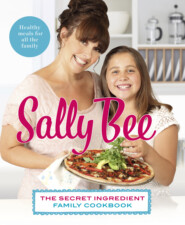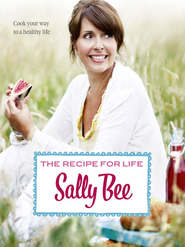По всем вопросам обращайтесь на: info@litportal.ru
(©) 2003-2024.
✖
The Secret Ingredient: Delicious,easy recipes which might just save your life
Автор
Год написания книги
2018
Настройки чтения
Размер шрифта
Высота строк
Поля
At this point, I was wired up to monitors and machines and felt overwhelmed and in a complete state of shock. Nobody can really explain why I survived that night. According to all the medical books, I shouldn’t have. My condition is incredibly rare, with only 200 or so recorded cases worldwide and about 30 survivors - ever! However, I was also fit, a healthy eater and a non-smoker, so this all worked in my favour. I am also a great believer in fate, and with three babies at home I had the most precious of reasons to keep breathing.
I could tell that the doctors were struggling the next day to say something positive to me. But they couldn’t. They believed that although I had survived the heart attacks, my chances of pulling through the next 24 hours were very slim. They were kind and gentle but, in this instance, they couldn’t perform miracles.
eating for health
Well, as you have probably gathered, having survived the un-survivable, my future health became so very important to me. I realized that I was the only person who could control how long I was to be around. Food and exercise became my saviour - and this book is my eating plan.
Here, you will find the recipes I devised when my prognosis was poor and I knew I had to take control of everything I ate in order to give myself the best possible chance of survival. At the same time I had three hungry cherubs at home and I was determined that they should grow up with a great relationship with food, as I had. I certainly didn’t want them to grow up thinking that a diet of mung beans and spinach was normal! So, scattered through my recipes you will find some ingredients often considered ‘unhealthy’. I’d like to take the opportunity to address each of these so that you fully understand what the facts are.
The first point to make is that ‘good food’ and ‘bad food’ is an old message steeped in myth and half-truth. I believe that many people have picked up unhelpful pieces of advice that they now hang on to, but actually these so-called ‘facts’ are making it far more difficult for them to enjoy a healthy diet for life. I know that the key to eating well is balancing nourishment with enjoyment; moderation is essential and it is possible to eat for health and taste in equal measure. I hope that after reading my book you’ll find it very easy to make good food choices and at the same time enjoy your food as you deserve to.
So, you’ll see that some delicious recipes that contain red meat. It is true that chicken and fish would usually be the preferred option; however, red meat is a valuable source of iron and zinc and eaten in small quantities is good for you. Be sure to buy top-quality lean meat and always cut off all visible fat. All of my dishes that contain red meat also have a high vegetable content and so are perfectly balanced to give your body the nutrients it needs.
Some recipes contain a little butter or cheese. They are a good source of calcium, however, and the quantities used are very small. What’s more the dishes are designed to feed at least four people and so do not contain enough dairy to be detrimental to your health when eaten in moderation.
Keep a close watch on which dishes are marked ‘everyday and which are marked ‘treat’. I have done this to guide you. An ‘everyday’ dish speaks for itself, but try to limit the ‘treats’ to once a week or once every two weeks to be on the fun side of safe!
Potatoes get a bad press - possibly because we often think of them loaded with fat as chips and crisps. However, in their natural form they are fat free, high in fibre and a good source of vitamin C. They are also affordable, keep well and are incredibly versatile. I use potatoes all the time, such as when I need to bulk out a meal if we have unexpected guests.
I suspect that some of you will have been put off potatoes because of the recent fashion for carbohydrate-free diets. However, please understand that your body needs a little carbohydrate every day and it’s much better to get it from a high-fibre food like a potato than a low-fibre starchy food like bread or pasta.
Eggs also have an unfairly bad reputation. They contain cholesterol, and so it is often thought that people who have high blood cholesterol should not eat eggs. Actually, the cholesterol in an egg is not absorbed into the blood stream. Each yolk contains around 5g of fat (about 8 per cent of the daily amount we should have), of which only 1.5g is saturated (i.e. bad for you). Although they should not be eaten every day, they are a good source of protein and contain more than a dozen vitamins and minerals, including iron, zinc, phosphorus, folate, riboflavin, vitamins A, D, E and B12. So you can see that from a nourishment point of view an egg packs quite a punch! I’d call that healthy eating, wouldn’t you?
I have included some of my favourite family recipes, such as lasagne, shepherd’s pie and even egg and chips (see pages 95,99 and 41)! Take a closer look and you’ll see that even these recipes contain only a little olive oil and are packed with nutrients from the high vegetable content. For most people, nutrition is an art and not a science. We all wish to eat well and be healthy and my recipes will help you achieve just that. I want you and your family to enjoy a healthy diet as much as my family and I do.
Enjoy!
p.s. The oven temperatures in this book are for a conventional oven. If you are using a fan oven, follow the manufacturer’s instructions.
soups & starters (#ulink_cbbf916d-6a9b-5d91-8556-e11e13333b5b)
carrot and butternut squash soup
everyday
(#ulink_591cd538-11c8-5450-bd04-ee1d564e6115)
This soup is so quick and easy to make and is wonderfully good for you. It will keep for up to a week in the refrigerator.
serves 4
1 red onion, peeled and finely chopped
2 garlic cloves, peeled and finely chopped
2 tbsp olive oil
4 large carrots, peeled
1 medium butternut squash, peeled and deseeded
freshly ground black pepper
850ml/1½ pints/3¾ cups chicken or vegetable stock
2–3 fresh thyme sprigs, leaves picked
handful of chopped fresh parsley or coriander (cilantro)
1 Sweat the onion and garlic in the olive oil over a medium heat in a large, lidded pan for about 7 minutes, or until soft.
2 Chop the carrots and butternut squash into 1.5cm/⅝in cubes and add to the pan. Season with black pepper and cook for another 10 minutes, or until the vegetables start to soften.
3 Pour in the stock, add the thyme leaves and parsley or coriander (cilantro) and bring to the boil. Now turn down the heat a little, cover and simmer for about 30 minutes.
4 Finally, use a hand blender or liquidizer to purée the soup. Reheat and serve.
courgette and pea soup
everyday
An easy-to-make soup that is packed with beta-carotene, vitamin C and folate. Tastes good too!
1 Heat the olive oil in a medium-sized saucepan over a moderate heat. Add the courgettes (zucchini) and onion and sauté for about 10 minutes, or until the vegetables start to soften.
2 Pour in the stock, then bring to the boil, lower the heat and simmer, covered, for 15 minutes.
3 Add the peas to the soup and simmer for a further 5 minutes.
4 Blend the soup in a liquidizer or blender and stir in the basil.
5 Reheat, season to taste with black pepper and serve immediately.
serves 6
dash of olive oil
4 small courgettes (zucchini), chopped into small pieces
1 small onion, peeled and sliced
900ml/1½ pints/3½ cups chicken stock
225g/8oz/2 cups fresh or frozen peas
25g/1oz fresh basil, torn
freshly ground black pepper








